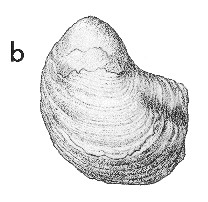
Revised descriptions of New Zealand Cenozoic Mollusca from Beu and Maxwell (1990)

 | Revised descriptions of New Zealand Cenozoic Mollusca from Beu and Maxwell (1990) | 
|
  (Pl. 3b): GS1177, CH/f3, Tioriori, Chatham Islands, Waipawan (hypotype of Marwick 1928, figs. 93–96) (TM2931, GNS) |
  (Pl. 3c): GS1177, CH/f3, Tioriori, Chatham Islands, Waipawan (hypotype of Marwick 1928, figs. 93–96) (TM2931, GNS) |
Beu & Maxwell (1990): Chapter 6; p. 91; pl. 3 b, c.
Synonymy: Gryphaea tarda Hutton 1873b, p. 35; Notostrea tarda; Ostrea (Notostrea) tarda
Classification: Gryphaeidae: Pycnodonteinae
Description: Small for genus (height 35-60 mm), gryphaeiform, strongly inequivalve with left (lower) valve highly inflated and incurved, right valve flat or concave. Some shells subequilateral, others strongly oblique. Left valve with shallow posterior radial sulcus. Attachment area absent or very small, confined to apex. Shell with vesicular structure typical of Pycnodonteinae. No sculpture apart from growth lines and ridges. Ligamental area small with relatively large resilifer; left valve with narrow commissural shelf well within shell to take margins of right valve. Chomata restricted to area near hinge, weakly developed in some shells, absent from others. Adductor muscle scar subcircular, situated much closer to hinge than to ventral margin.
Comparison: Pycnodonte (Notostrea) tarda differs from the poorly known P. (Notostrea) subdentata (PI. 9b, f) — the type species of the subgenus — in its larger size, more strongly inflated and incurved left valve, and much weaker chomata. The shape is strongly reminiscent of the Late Triassic to Late Jurassic genus Gryphaea Lamarck, 1801, but the presence of vesicular shell material in P. (Notostrea) tarda indicates affinities with Pycnodonteinae rather than Gryphaeinae. Stenzel (1971, p. N1094, N1168) considered Notostrea to be "valueless" and of uncertain taxonomic position. It is here classed as a subgenus of Pycnodonte, differing from that taxon primarily in its elongate rather than subcircular outline, in having a very short hinge and in having the left valve umbo projecting well above the dorsal margin.
Pycnodonte (Notostrea) lubra Finlay (in Marwick 1928, p.432; new name for Gryphaea tarda "Hutton" of Tate, not of Hutton) is a southern Australian Middle or Late Eocene species closely resembling P. (N) tarda. Although described from the Great Australian Bight, P. lubra is best known in a thin greensand bed between the two Eocene molluscan assemblages in mudstone at Browns Creek, Johanna, west of Cape Otway, Victoria, recorded by Darragh (1985, p. 100). To our knowledge, these three are the only species that have been referred to P. (Notostrea). However, these species are very similar in all characters to those referred to Phygraea Vyalov, 1936 (Stenzel 1971, p. N1107, fig. J83.1), and it seems likely that Notostrea is simply an earlier name for Phygraea. Species referred to Pyconodonte (Phygraea) occur widely ("Cretaceous-Miocene, world-wide"; Stenzel 1971, p. N1107) and this is probably a cosmopolitan genus occurring in New Zealand. At present, the poor knowledge of the type species, P. subdentata, prevents the replacement of Phygraea by Notostrea. P. (Notostrea) tarda has a very small attachment area or lacks one entirely, suggesting that it lay free on the seafloor during most of its life. Maxwell (1992, p. 69 (tentatively); 2009, p. 234) transferred Pycnodonte mackayi (Suter, 1917) to P. (Notostrea) also, but this species is less certainly consubgeneric with P. tarda.
Distribution: Waipawan, "Chatham Island" (type — probably from Red Bluff Tuff in the Pukekio-Point Weeding section near Waitangi); Tutuiri Greensand, Tioriori, north Chatham coast where it is very abundant (mistakenly thought to be the type locality by Marwick (1928, p. 462)) - also several other localities in Red Bluff Tuff and Matanginui Limestone, Chatham Islands. Not yet recorded from mainland New Zealand.
Cite this publication as: "A.G. Beu and J.I. Raine (2009). Revised
descriptions of New Zealand Cenozoic Mollusca from Beu and Maxwell (1990). GNS
Science miscellaneous series no. 27."
© GNS Science, 2009
ISBN
978-0-478-19705-1
ISSN 1177-2441
(Included with a PDF facsimile file
copy of New Zealand Geological Survey Paleontological Bulletin 58 in CD version
from: Publications Officer, GNS Science, P.O. Box 30368 Lower Hutt, New
Zealand)